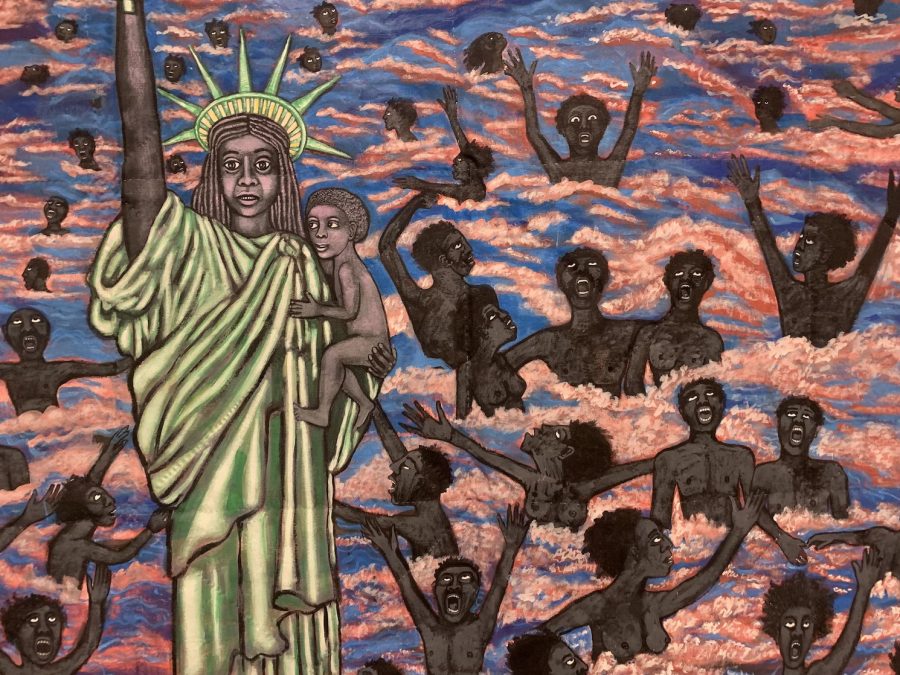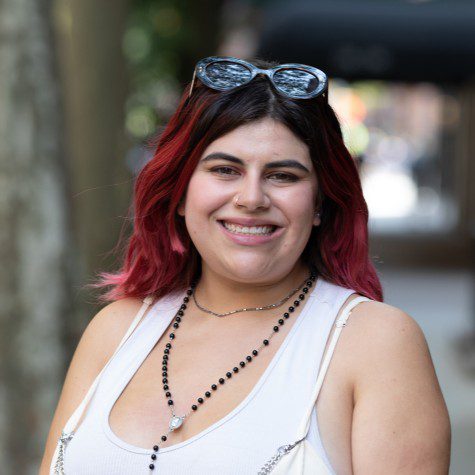Review: ‘Faith Ringgold: American People,’ is a triumphant rendition of Black America
The New Museum’s current Faith Ringgold retrospective offers an insightful perspective on the fight for Black and women’s liberation over the past six decades.
Faith Ringgold’s “We Came to America” grapples with troubled histories of Blackness as told through slavery and liberation. (Photo by Natalia Palacino Camargo)
April 4, 2022
Faith Ringgold is a trailblazer in the modern American art scene. She has redefined the narrative for Black female artists; her pieces are featured in the Museum of Modern Art’s permanent collection, and she’s taken on the role of an activist through her work documenting the civil rights movement, switching between textiles and paintings. Now, Ringgold’s work has made its way downtown for her first — and long-overdue — retrospective, “Faith Ringgold: American People.”
Currently on display in the New Museum from Feb. 17 to June 5, the exhibit spans over 60 years of Ringgold’s career and occupies half of the museum’s limited space. As an artist, author and educator, Ringgold narrates the histories of Black America through her work and raises difficult political topics through playful visuals. This retrospective takes an exhaustive look at Ringgold’s pieces, exploring everything from her work in children’s books to her artistic practice in quilting.
Ringgold’s work blurs the lines between reality and fiction as she narrates collective histories of Blackness through autobiographical and fictional narratives. She documents her life as a mother and artist, while also narrating the experience of influential African American figures and movements; for example, her poster “Power to the People” (1970) advocated for the Black Panther Party and freeing political prisoners with simple geometric shapes and primary colors.
As one of the most influential creators of her generation, the Harlem-born artist has spent decades exploring the intersections between the Black liberation and women’s liberation movements. Ringgold’s multidisciplinary art highlights a history of Black trauma and resilience, like the high tension within the piece “We Came to America” (1997), which depicts the drowning of Black people. Her other work depicts joyful scenes, such as “Tar Beach #2” (1990), a piece that celebrates the urban landscape and imagination with imagery of Black children dreaming and flying around the colorful city against the New York skyline.
Through her use of visual language, Ringgold makes her work accessible to both children and adults as she aims to inform all people. Additionally, in her children’s books, displayed on the last floor, Ringgold captures what it means to be Black in America as she retells the stories of civil rights activists such as Rosa Parks in “If a Bus Could Talk: The Story of Rosa Parks” and Martin Luther King Jr. in “My Dream of Martin Luther King”.

This exhibition also speaks to the evolution of Ringgold’s visual language. Despite the change in style from her graphic color-block paintings of the civil rights movement to her Harlem-inspired works with more muted tones, her work continually carries a message of power and community. Featured works in the exhibition include the iconic “American People Series #18: The Flag Is Bleeding” (1967), which depicts a bleeding American flag, and “Echoes of Harlem” (1980), which is a collaborative quilt between Ringgold and her mother that collages the faces of the residents of Harlem.
The exhibition also features Ringgold’s popular series, “The French Collection” (1991-97), which presents a series of 12-story quilts that place Black figures into recognizable European paintings. It is delicately curated with its own room in the museum, balancing the complexity of the quilts with the museum walls painted in dark blue tones that bring out the detailed embroidery.
Ringgold’s work contrasts traditional European large-scale work and subverts the erasure of Blackness in Western art. By inserting Black bodies into recognizable 19th- and 20th-century works, Ringgold challenges the idea that Black people are not subjects of value. Ringgold uses quilting as an act of defiance and power, essential in reshaping the narratives surrounding the practice, which was often relegated to utilitarian housework in the 20th century.
Ringgold is an artist ahead of her time who, through her figurative style, held no reservations in exploring urgent topics in political and social change. For example, her MoMA centerpiece “American People Series #20: Die” (1967), borrowed for the New Museum’s exhibit, depicts a bloody scene of well-dressed Black and white people. Ringgold created this piece to document the racial tension in the 1960s and critique the complacency of the upper class. The violence depicted in her works resonate even more strikingly as they remain relevant to the hate crimes and racism today.
“Faith Ringgold: American People” is an exhibit that tells an inspiring and subversive narrative — an alternate history of power and resilience. Through her impressive technique and narrative skills, Ringgold shows that Black women play an essential role in modern art history.
Contact Natalia Palacino at [email protected].

























































































































































